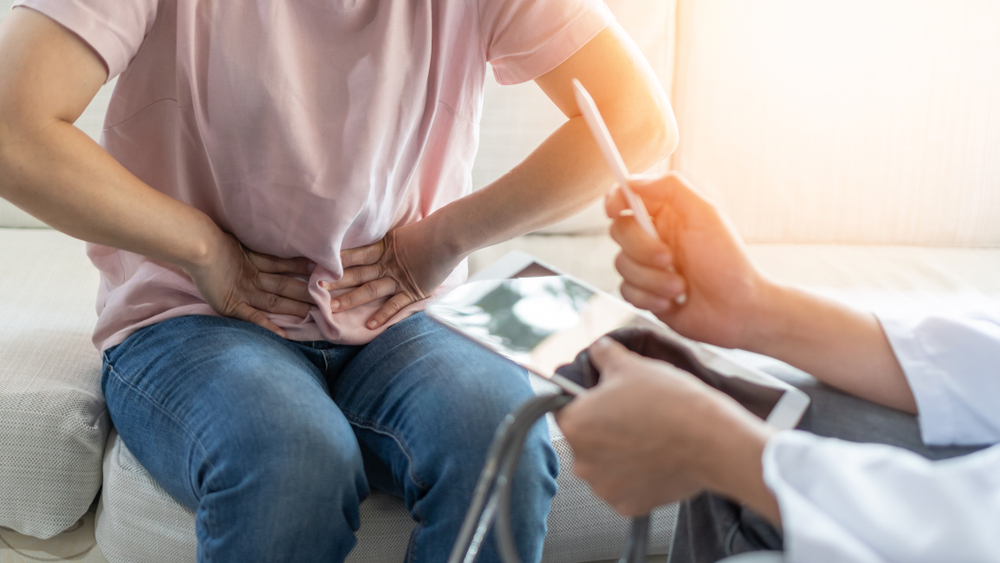Here, you can learn about the connection between hernias and bowel obstructions. We also will share some advice to help you make proper health decisions for yourself or your family.
Abdominal Hernia Triggers and Causes
Abdominal hernias occur when an intestine works its way through a weak spot in the abdominal wall. If the intestine gets squeezed by the hernia, it can lead to more problems. The intestine may become cut off from its blood supply and become a strangulated hernia. Tears in the abdominal wall or abdominal muscles, usually lead to hernias appearing around the belly button. However, they may also appear near or around the groin, which are called inguinal hernias.
This painful situation develops when excessive pressure is placed on the bowels to cause primary tissue weakness. Multiple types of force can contribute to the development of this painful condition and its worsening.
For example, people who lift heavy objects may put undue strain on their abdomen that triggers a hernia. Strain can cause and worsen a hernia through weakened tissue in the abdominal wall.
Other things that put pressure on your abdomen include diarrhea, constipation, or persistent coughing and sneezing. Additionally, poor nutrition or obesity may be associated with hernias. These factors increase a person’s risk of developing hernias and, even worse, of suffering from problematic bowel obstructions.
What Does a Hernia Feel Like?
A protrusion along the outside surface of the abdomen may be visible or felt if you have a hernia in the belly area. Hernia patients report minor pain, aching, or a pressing sensation at the hernia site. Any action that exerts pressure on the abdomen, such as heavy lifting, jogging, or bowel motions, exacerbates the discomfort. Some patients have a bulge but are not bothered by it.
It’s also not uncommon for a hernia to be mistaken for a hematoma or a lipoma. A lipoma is a non-cancerous, superficial tumor that can look like a hernia lump. Hematomas can also look similar, but these disappear on their own and often follow an injury or impact.
HERNIA SYMPTOMS
When a hernia develops in a person’s body, they can experience several symptoms. Hernia symptoms can include:
- Severe pain in the lower abdomen
- General abdominal pain
- General weakness
- Gurgling stomach
- Acid reflux
- Chest pain
- Bulges around your abdomen
- Soreness around the bulge
- Burning sensations around the bulge
- Pain when moving
HOW HERNIAS PRESENT IN WOMEN VS MEN
The physical presentation and symptoms of a hernia can present differently with women compared to men. A classic hernia bulge can appear smaller with women, whereas with men there is a high frequency of a visible protrusion of a hernia.
Pain from a hernia can also be confused with common gynecological conditions such as endometriosis or ovarian cysts. WIth the combination of other pain-inducing conditions and a lack of a visual manifestation, it can be difficult for a hernia to be diagnosed in a woman through standard hernia examinations.
Although most hernias are harder to diagnose in women, umbilical hernias are an exception. Umbilical hernias occur in the abdominal wall around your belly button when fatty tissue or your intestines start to push through a weaker area of muscle. During pregnancy, women are more likely to develop umbilical hernias due to the increased pressure their growing baby puts throughout their abdomen. Umbilical hernias are easy to see around the belly button, making it a much easier diagnosis.
When to Worry About Hernia Pain
While most people will have discomfort, they may not think it is significant enough to take action. Some people won’t notice a hernia until severe pain and symptoms begin. If you think that you could have a hernia, be sure to seek medical advice because treatment may be needed.
WHAT IS A BOWEL OBSTRUCTION?
An obstructed bowel, also known as a bowel obstruction or intestinal obstruction, occurs when a blockage prevents the normal flow of food, liquid, and gas through the digestive tract. This blockage can occur in various parts of the gastrointestinal system, including the small intestine or the colon. Bowel obstructions can be either partial or complete.
What Causes a Bowel Obstruction?
How Do You Know If You Have A Bowel Obstruction?
- Severe abdominal pain
- Bloating
- Vomiting
- Constipation
- Inability to pass gas
A bowel obstruction is a serious medical condition that requires prompt medical attention. An untreated bowel obstruction can lead to bowel tissue damage, infection, and other complications. While symptoms overlap, an obstruction can feel different depending on where it’s coming from. Specifically, a small bowel obstruction can feel localized and bring abdomen pain in waves, whereas a large bowel obstruction can bring consistent pain and cramping.
HERNIAS THAT TRIGGER BOWEL OBSTRUCTIONS
When the small intestine herniates, the intestine becomes restricted and is usually cut off from its blood supply. The restriction also makes it more difficult for digesting materials to pass through into the large intestine.
The severity of this issue varies depending on the level of the hernia and the type of hernia that develops.
Common types of hernias that cause intestinal obstructions include inguinal hernias, femoral hernias, and incisional hernias.
Hiatal hernias are another common type of hernia but occur in the upper digestive system. So, they typically do not cause bowel obstructions. Rather, they can lead to acid reflux and chest pain.
INGUINAL HERNIAS
- A bulge on either the right or left of the pubic bone that’s more visible under physical stress, including while coughing
- Itching and pain around the bulge
- Burning sensations around the bulge
- Pain and discomfort while walking, bending, lifting, or coughing
- Heaviness around the groin
- A dragging feeling in the groin
- Pressure in the groin area
- Weakness around the groin
Depending on the severity of the hernia, a male patient may experience pain and swelling around the testicles, especially if the herniated intestine descends into the scrotum. Inguinal hernias can sometimes be pushed back into place without surgery but will require surgical attention eventually.
If left untreated, inguinal hernias can lead to complications, such as bowel obstruction or strangulation, which are more serious and require immediate medical attention.
FEMORAL HERNIAS
Femoral hernias are more common in women than in men, and they tend to occur in the area where the femoral artery passes through the abdominal wall. The main symptoms of femoral hernias include:
- A visible bulge or swelling in the upper thigh or groin area
- Sudden pain in the groin or thigh
- Abdominal pain
- Discomfort
- A feeling of fullness or pressure in the groin
- Nausea or vomiting
It is important to seek medical attention if you suspect you have a femoral hernia or experience the above symptoms. Prompt diagnosis and surgical intervention can help prevent complications and alleviate the discomfort associated with this type of hernia.
The primary treatment for a femoral hernia is surgery, which typically involves pushing the herniated tissue back into place and reinforcing the weakened abdominal wall area. Surgery can be done using traditional open techniques or minimally invasive laparoscopic methods.
INCISIONAL HERNIAS
This type of hernia can result from poor wound healing, infection, or tension on the incision during the healing process. It’s more common after abdominal surgeries, such as appendectomy, gallbladder removal, or hernia repair.
Common symptoms include:
- A visible bulge or swelling at the surgical scar site
- A bulge that is red with a burning sensation
- Discomfort or pain at the incision site
- Constipation due to bowel obstruction
Those who have had or are about to have abdominal surgery, need to be aware of the risk of incisional hernias and promptly seek medical attention if any signs or symptoms show. Early diagnosis and treatment can help prevent complications and ensure a successful hernia repair.
Types of Hernia Repair Surgery
This treatment option varies depending on the type of hernia and the severity of the injury. For example, open hernia repair requires opening up the body and pushing the hernia back into place. Laparoscopic hernia repair uses smaller incisions paired with a tube to insert repair tools carefully.
With new advances in technology, robotic laparoscopic surgery is now available here in Tennessee. These procedures are far less invasive than open surgery, allowing the patient to recover in less time.
WHAT ARE THE LONG-TERM EFFECTS OF UNTREATED HERNIAS AND BOWEL OBSTRUCTIONS?
Ignoring the symptoms of a hernia or bowel obstruction can have serious consequences. If left untreated, these conditions can lead to life-threatening complications.
Recognizing Urgent Symptoms
If you notice any of the following symptoms, it’s crucial to speak with your medical provider right away:
- Sudden pain that worsens quickly
- Nausea and vomiting
- Fever
- Discoloration of your hernia bulge, especially if it’s red, purple, or darkened
- Constipation or inability to pass gas
These can all be signs that the blood supply to your hernia has been cut off, which can lead to tissue death if not treated properly. Tissue death, known as necrosis, is one of the most dangerous risks of untreated hernias and bowel obstructions.
This is a medical emergency that requires immediate surgery to remove the damaged tissue and repair the hernia.
Bowel obstructions can also lead to tissue death if left untreated. The blocked intestine can become distended and lose its blood supply, causing the tissue to die. In severe cases, this can lead to a perforation, or a hole in the intestine, which can cause infection and sepsis. In addition to tissue death, untreated hernias and bowel obstructions can cause chronic pain and discomfort.
The bulge from a hernia can become larger and more painful over time, and the pressure on the intestine from a bowel obstruction can cause ongoing pain and discomfort.
Can a Hernia Heal Itself?
Unfortunately, a hernia does not heal itself. Remember a hernia occurs after a weakness in the surrounding muscle or tissues, and the body cannot repair this weak spot without medical attention. Leaving a hernia alone can bring complications over time, like a bowel obstruction.
WHEN TO SEE A HERNIA SPECIALIST
The dangers of hernias and bowel obstructions are too severe to ignore. Surgical repair is necessary if you want relief from the painful effects of intestinal obstruction.
If you or someone you love has a hernia or similar concerns, set up your appointment at The Surgical Clinic today. Our team will examine the issue and take steps to manage it quickly and efficiently.
General surgeons in Greater Nashville

Dr. John Boskind
General Surgeon
MT. JULIET

Dr. Mariana Chavez
General Surgeon
Downtown

Dr. Patrick Davis
General Surgeon
SOUTHERN HILLS

Dr. Gretchen Edwards
General Surgeon
DOWNTOWN

Dr. Alex Fruin
General Surgeon
MT. JULIET

Dr. James Griscom
General Surgeon
NASHVILLE

Dr. Mark Hinson
General Surgeon
COLUMBIA

Dr. George Lynch
General Surgeon
NASHVILLE

Dr. Clinton Marlar
General Surgeon
SKYLINE

Dr. Willie Melvin
General Surgeon
SMYRNA

Dr. Chad Moss
General Surgeon
COLUMBIA

Dr. William Polk
General Surgeon
NASHVILLE

Dr. Drew Reynolds
General Surgeon
SAINT THOMAS WEST

Dr. Joshua Taylor
General Surgeon
SMYRNA

Dr. Davidson Oxley
General Surgeon
COLUMBIA

Dr. Tyson Thomas
General Surgeon
SAINT THOMAS WEST

Dr. John Valentine
General Surgeon
HENDERSONVILLE

Dr. Patrick Wolf
General Surgeon
SAINT THOMAS WOLF

